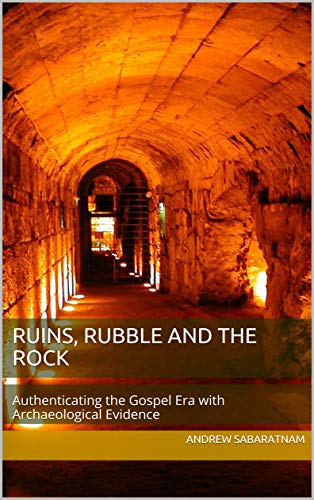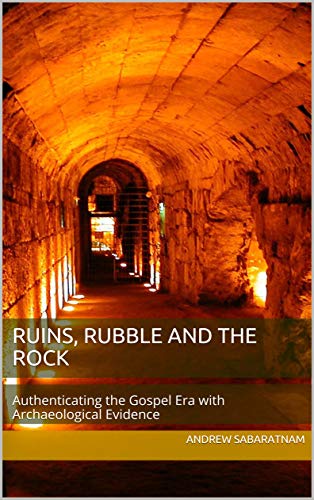Join our list
Subscribe to our mailing list and get interesting stuff and updates to your email inbox.
 Author(s): Andrew Sabaratnam
Author(s): Andrew SabaratnamPublisher: N/A
Price: $3.99
Why were stone jars used in Cana when the rest of the ancient world used clay vessels? Why did Jesus heal the crippled man instantly at the pool of Bethesda but tell the blind man to wash in the Pool of Siloam? Why did Jesus talk about the gates of Hades specifically at Caesarea Philippi? Why did Jesus mock the religious teachers and Pharisees for sitting in the Moses’ seat? Books on Biblical archaeology are often written (a) as a reference source for biblical, theological, and apologetic studies, (b) to provide a deeper appreciation of the Biblical world, or (c) to let you know that the stories of the Bible are neither fictional nor allegorical. The goal of this book is none of these. The goal of this book is to use Biblical archaeology to authenticate the biblical narratives in the Gospel era. In every chapter, complex topics are made easy to understand so that everyone can lay hold of it. In every chapter, as we dig into the ruins and the rubble, the stones reveal to us more about the Rock of our salvation, Jesus Christ.
- Share
- Like
- Tweet
- Digg
- Tumblr
- VKontakte
- Buffer
- Love This
- Odnoklassniki
- Meneame
- Blogger
- Amazon
- Yahoo Mail
- Gmail
- AOL
- Newsvine
- HackerNews
- Evernote
- MySpace
- Mail.ru
- Viadeo
- Line
- Comments
- SMS
- Viber
- Telegram
- Subscribe
- Facebook Messenger
- Kakao
- LiveJournal
- Yammer
- Edgar
- Fintel
- Mix
- Instapaper
- Copy Link
 Author(s): Andrew Sabaratnam
Author(s): Andrew SabaratnamPublisher: N/A
Price: $3.99
Why were stone jars used in Cana when the rest of the ancient world used clay vessels? Why did Jesus heal the crippled man instantly at the pool of Bethesda but tell the blind man to wash in the Pool of Siloam? Why did Jesus talk about the gates of Hades specifically at Caesarea Philippi? Why did Jesus mock the religious teachers and Pharisees for sitting in the Moses’ seat?
Books on Biblical archaeology are often written (a) as a reference source for biblical, theological, and apologetic studies, (b) to provide a deeper appreciation of the Biblical world, or (c) to let you know that the stories of the Bible are neither fictional nor allegorical. The goal of this book is none of these. The goal of this book is to use Biblical archaeology to authenticate the biblical narratives in the Gospel era.
In every chapter, complex topics are made easy to understand so that everyone can lay hold of it. In every chapter, as we dig into the ruins and the rubble, the stones reveal to us more about the Rock of our salvation, Jesus Christ.
- Share
- Like
- Tweet
- Digg
- Tumblr
- VKontakte
- Buffer
- Love This
- Odnoklassniki
- Meneame
- Blogger
- Amazon
- Yahoo Mail
- Gmail
- AOL
- Newsvine
- HackerNews
- Evernote
- MySpace
- Mail.ru
- Viadeo
- Line
- Comments
- SMS
- Viber
- Telegram
- Subscribe
- Facebook Messenger
- Kakao
- LiveJournal
- Yammer
- Edgar
- Fintel
- Mix
- Instapaper
- Copy Link
 Author(s): Andrew Sabaratnam
Author(s): Andrew SabaratnamPublisher: N/A
Price: $3.99
Why were stone jars used in Cana when the rest of the ancient world used clay vessels? Why did Jesus heal the crippled man instantly at the pool of Bethesda but tell the blind man to wash in the Pool of Siloam? Why did Jesus talk about the gates of Hades specifically at Caesarea Philippi? Why did Jesus mock the religious teachers and Pharisees for sitting in Moses’ seat?
Books on Biblical archaeology are often written (a) as a reference source for biblical, theological, and apologetic studies, (b) to provide a deeper appreciation of the Biblical world, or (c) to let you know that the stories of the Bible are neither fictional nor allegorical. The goal of this book is none of these. The goal of this book is to use Biblical archaeology to authenticate the biblical narratives in the Gospel era.
In every chapter, complex topics are made easy to understand so that everyone can lay hold of it. In every chapter, as we dig into the ruins and the rubble, the stones reveal to us more about the Rock of our salvation, Jesus Christ.
- Share
- Like
- Tweet
- Digg
- Tumblr
- VKontakte
- Buffer
- Love This
- Odnoklassniki
- Meneame
- Blogger
- Amazon
- Yahoo Mail
- Gmail
- AOL
- Newsvine
- HackerNews
- Evernote
- MySpace
- Mail.ru
- Viadeo
- Line
- Comments
- SMS
- Viber
- Telegram
- Subscribe
- Facebook Messenger
- Kakao
- LiveJournal
- Yammer
- Edgar
- Fintel
- Mix
- Instapaper
- Copy Link
 Author(s): Andrew Sabaratnam
Author(s): Andrew SabaratnamPublisher: N/A
Price: $3.99
Why were stone jars used in Cana when the rest of the ancient world used clay vessels? Why did Jesus heal the crippled man instantly at the pool of Bethesda but tell the blind man to wash in the Pool of Siloam? Why did Jesus talk about the gates of Hades specifically at Caesarea Philippi? Why did Jesus mock the religious teachers and Pharisees for sitting in the Moses’ seat?
Books on Biblical archaeology are often written (a) as a reference source for biblical, theological, and apologetic studies, (b) to provide a deeper appreciation of the Biblical world, or (c) to let you know that the stories of the Bible are neither fictional nor allegorical. The goal of this book is none of these. The goal of this book is to use Biblical archaeology to authenticate the biblical narratives in the Gospel era.
In every chapter, complex topics are made easy to understand so that everyone can lay hold of it. In every chapter, as we dig into the ruins and the rubble, the stones reveal to us more about the Rock of our salvation, Jesus Christ.
- Share
- Like
- Tweet
- Digg
- Tumblr
- VKontakte
- Buffer
- Love This
- Odnoklassniki
- Meneame
- Blogger
- Amazon
- Yahoo Mail
- Gmail
- AOL
- Newsvine
- HackerNews
- Evernote
- MySpace
- Mail.ru
- Viadeo
- Line
- Comments
- SMS
- Viber
- Telegram
- Subscribe
- Facebook Messenger
- Kakao
- LiveJournal
- Yammer
- Edgar
- Fintel
- Mix
- Instapaper
- Copy Link







